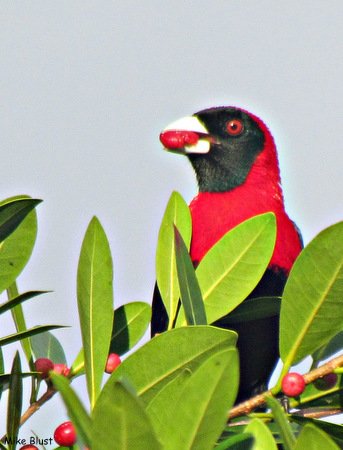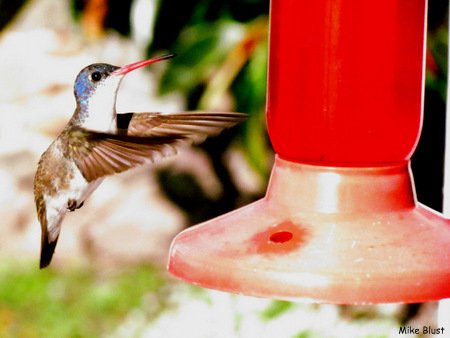 Crimson-collared Tanager“Watching birds and eating bugs” – that’s how Mike Blust characterized the highlights of his September 2011 to November 2103 sojourn in Mexico as a Peace Corps volunteer. He spoke and showed photos of his experience at the Rutland Free Library on February 10, 2015 in an evening program sponsored by RCAS.
Crimson-collared Tanager“Watching birds and eating bugs” – that’s how Mike Blust characterized the highlights of his September 2011 to November 2103 sojourn in Mexico as a Peace Corps volunteer. He spoke and showed photos of his experience at the Rutland Free Library on February 10, 2015 in an evening program sponsored by RCAS.
Watching birds has been a lifelong endeavor of Mike’s, a Ph.D. professor emeritus of biology at Green Mountain College, with special interests in ornithology and entomology and ongoing dragonfly research.
He and his wife, Evangelina, were based at Santiago de Anaya, Hidalgo, Mexico, a town of 2000 people at 7000 feet on the edge of a high plateau, 3-4 hours northeast of Mexico City. They lived in a small modest brick house. Although initially unfurnished, they readily found the basics and Evangelina put in a soon flourishing flower garden. It was not primitive living. They had a microwave and internet connection. But the house was not heated, and winter nights at 30-40 degrees F meant sleeping in their jackets.
Mike worked with the state agency of environmental and natural resources which was concerned that the local populace was overharvesting their endemic insects. The native Otomi Indians have always lived off the land, depending on it for food, including insects which are an important part of their diet. This is celebrated in the annual spring Otomi Indigenous Food Festival at which a football field sized white tent houses long tables at which contestants show off their prized insect-inspired recipes and delicacies. Visitors from a wide area flock to the event.
Four insects are commonly consumed. The pupa of the escamole ant is fried and mixed into dishes. Chinicuile worms, which live around the roots of the agave plant, are fried for snacks. The caterpillar of chicharas, which is found amidst the leaves of the agave, is also considered savory. Lastly, the mesquite bug, which feeds on the mesquite tree, Mike described as tasting rather sweet.
 Violet-crowned HummingbirdAfter observing for the first few months, Mike concluded that the people knew a lot about harvesting and cooking, but didn’t have a knowledgeable grounding in the ecology and biology of their environment. His goal became the cultivation of a program for sustainable harvesting and management. As a part of this, he led the local farmers in planting a 2500 agave demonstration plot as a ‘no harvest zone” to try to increase the number of insects.
Violet-crowned HummingbirdAfter observing for the first few months, Mike concluded that the people knew a lot about harvesting and cooking, but didn’t have a knowledgeable grounding in the ecology and biology of their environment. His goal became the cultivation of a program for sustainable harvesting and management. As a part of this, he led the local farmers in planting a 2500 agave demonstration plot as a ‘no harvest zone” to try to increase the number of insects.
Evangelina latched onto similar goals, but focused on children’s education. She found the school system well-intentioned but sorely lacking in rigor. Pupils were encouraged to love the trees and animals, but had no familiarity with even common names much less species biology and interdependence. She developed illustrated information sheets on the trees, mammals, plants, birds, etc. with details on identification, life cycles, habitat and interrelationships. These were laminated and placed, with a bird bingo game, into “toolboxes for environmental and bio-cultural education,” sturdy green canvas tote bags which she designed and produced for distribution to numerous classrooms.
A secondary project of Mike’s was Saturday morning bird walks with high school students. They compiled a list of more than 100 common birds. Mike used photos of 72 of them to design an educational poster for schools.
“Time-off” was spent on intensive birding ventures. Highlights included seeing the Military Macaw in Oaxaca and participating in the Toh Birding Festival in the Yucatan. Overall, Mike saw 413 species.
The bird photos were enthralling, but Mike stressed their work with the people. The 21st century Peace Corps has matured from its origins. As experience and knowledge are gained, both in and outside of the program, its goals and projects have evolved in new directions and are often conceived and directed by the volunteers themselves as exemplified by Mike and Evangelina Blust in Mexico.